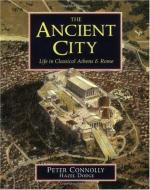
|
| Name: _________________________ | Period: ___________________ |
This test consists of 15 multiple choice questions and 5 short answer questions.
Multiple Choice Questions
1. The comedies that have an effect on later Roman comedy are the _____ and the ______.
(a) Campanian farce and the mime.
(b) Phylakes and the Mime.
(c) Campanian farce and Phylakes.
(d) Phlyakes and the Atellan farce.
2. These, built in 312 BC, provide a reliable source of water for Romans.
(a) Sewage plants.
(b) Wells.
(c) Water towers.
(d) Aqueducts.
3. The population of Rome in the 2nd century AD is about this many.
(a) 1,200.
(b) 120,000.
(c) 1,200,000.
(d) 12,000.
4. Places that serve hot food are important because of this.
(a) Many homes do not have kitchens.
(b) Many are single, and do not wish to cook for one.
(c) Many do not like dining at home.
(d) Many cannot afford groceries.
5. It is under these emperors that Rome comes into its Golden Age.
(a) Augustus and Maximus.
(b) Augustus and Caligula.
(c) Trajan and Hadrian.
(d) Nero and Celete.
6. Women are penalized if they are not married by this age.
(a) Twenty.
(b) Thirteen.
(c) Eighteen.
(d) Thirty.
7. The Forum Boarium was used to do this.
(a) Sell houses.
(b) Sell food.
(c) Sell livestock.
(d) Sell jewelry.
8. By the first century BC, theater is geared toward this.
(a) Public taste.
(b) Humor.
(c) Political satire.
(d) War.
9. Roman religion is _______ in origin.
(a) Agricultural.
(b) Architectual.
(c) Spiritual.
(d) Natural.
10. Roman foods are often highly _____.
(a) Spiced.
(b) Praised.
(c) Priced.
(d) Valued.
11. The toga is a sign of this.
(a) Slavery.
(b) Formality.
(c) Religion.
(d) Class.
12. Roman literature indicates this is widespread.
(a) Famine.
(b) Disease.
(c) Adultery.
(d) Poverty.
13. Formal education of young women in Rome is _____.
(a) Haphazard.
(b) Rare.
(c) Dangerous.
(d) Mandatory.
14. These help to organize small time businessmen of Rome.
(a) Laws.
(b) Unions.
(c) Politicians.
(d) Guilds.
15. Laws keeping women under the authority of her husband are _____ in early Roman history.
(a) Abolished.
(b) Upheld.
(c) Passed.
(d) Ignored.
Short Answer Questions
1. This is a typical style of tomb in Rome, as well as in Ostia.
2. All jockeys of chariots belong to ______.
3. The poor, unlike the wealthy, often live in these.
4. One of the most obvious characteristics of Roman entertainment is this.
5. The four Pompeian styles include the Masonry, large panels of color, scenery, and this.
|
This section contains 334 words (approx. 2 pages at 300 words per page) |

|




